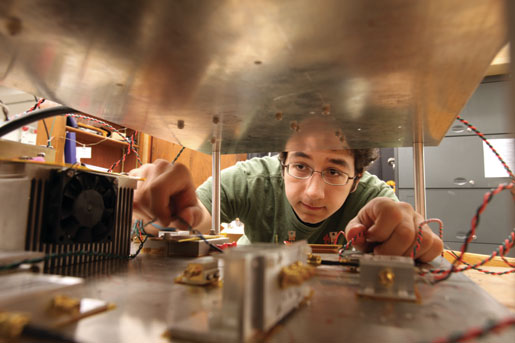
The oscillations inside of an atom are more regular than a pendulum—or virtually anything else.
“The electrons of atoms absorb and release radiation as they undergo shifts in energy. The frequency of this radiation can be used for measurement of time,” explains Sandro Gvakharia ’12, who is constructing an atomic clock as part of his senior honors thesis. While today’s best atomic clocks are accurate to within a second every billion years, such timepieces are big and need at least a meter of vertical room. Seth Aubin hopes to show in principle that a cold-atom atomic clock can be made much smaller, while limiting trade-offs in accuracy.
Gvakharia’s atomic clock is one of several spin-offs coming from the Aubin’s lab’s investigation of cold atoms. Aubin explains that all atoms display an internal waviness. Occasionally, this waviness is interrupted when two atoms collide. Such interruptions, or “clock shifts,” are responsible for that one second of drift every billion years.
Aubin explains that traditional atomic clocks send a fountain of cold atoms into the air, while an ultracold atom clock uses a magnetic trap to cool and hold atoms. Cold atoms move more slowly than room-temperature atoms; they make better atomic clocks because they have fewer colliding atoms. Ultra-cold atoms can have fewer yet; but there’s a trade off, because trapping ultra-cold atoms concentrates their density, increasing the clock shift.
To make a smaller clock, Aubin hopes to use fermions, particles with an inherent repulsive nature. Aubin expects the mutually repellent fermions will minimize collisions between the particles—and increase clock accuracy.
Accurate timekeeping is important to a number of applications. For example, your dashboard GPS works by measuring the time between signals sent and received between your car and a set of satellites. The importance of accurate timekeeping increases as distances grow.
Aubin notes that the lab receives funding from the Virginia Space Grant Consortium—itself funded by NASA, which wants the most accurate clocks possible to improve their tracking of deep-space probes, which may benefit from the construction of more compact atomic clocks. His lab has also received support from the Jeffress Memorial Trust and the Army Research Office.